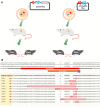Improved efficiency of genome editing by constitutive expression of Cas9 endonuclease in genetically-modified mice
- PMID: 33489675
- PMCID: PMC7801580
- DOI: 10.1007/s13205-020-02580-z
Improved efficiency of genome editing by constitutive expression of Cas9 endonuclease in genetically-modified mice
Abstract
Despite its convenience and precision, CRISPR-based gene editing approaches still suffer from off-target effects and low efficiencies, which are partially rooted in Cas9, the nuclease component of the CRISPR/Cas9 system. In this study, we showed how mouse genome editing efficiency can be improved by constitutive and inheritable expression of Cas9 nuclease. For this goal, a transgenic mouse line expressing the Cas9 protein (Cas9-mouse) was generated. For in vitro assessment of gene editing efficiency, the Cas9-mice were crossed with the EGFP-mice to obtain mouse embryonic fibroblasts (MEF) expressing both EGFP and Cas9 (MEFCas9-EGFP). Transfection of these cells with in vitro transcribed (IVT) EGFP sgRNA or phU6-EGFPsgRNA plasmid led to robust decrease of Mean Fluorescent Intensity (MFI) to 8500 ± 1025 a.u. and 13,200 ± 1006 a.u. respectively. However, in the control group, in which the MEFEGFP cells were transfected with a pX330-EGFPsgRNA plasmid, the measured MFI was 16,800 ± 2254 a.u. For in vivo assessment, the Cas9-zygotes at two pronuclei stage (2PN) were microinjected with a phU6-HhexsgRNA vector and the gene mutation efficiency was compared with the wild-type (WT) zygotes microinjected with a pX330-HhexsgRNA plasmid. The analysis of born mice showed that while the injection of Cas9-zygotes resulted in 43.75% Hhex gene mutated mice, it was just 15.79% for the WT zygotes. In conclusion, the inheritable and constitutive expression of Cas9 in mice provides an efficient platform for gene editing, which can facilitate the production of genetically-modified cells and animals.
Keywords: CRISPR-Cas9; Gene knock-out; Genetically-modified cells and mice; Microinjection.
© King Abdulaziz City for Science and Technology 2021.
Conflict of interest statement
Conflict of interestThe authors declare that they have no conflict of interest in the publication.
Figures




References
-
- Farzaneh F, Mirzapoor Z, Jahangirian E, Heidari F, Hashemi E, Rahim-Tayefeh A, Fatemi N, Jamshidizad A, Dashtizad M, Shamsara M. The chicken hypersensitive site-4 insulator cannot fully shield the murine phosphoglycerate kinase-1 promoter from integration site effects in transgenic mice. 3 Biotech. 2019;9:255. doi: 10.1007/s13205-019-1786-5. - DOI - PMC - PubMed
LinkOut - more resources
Full Text Sources
Other Literature Sources
Research Materials

